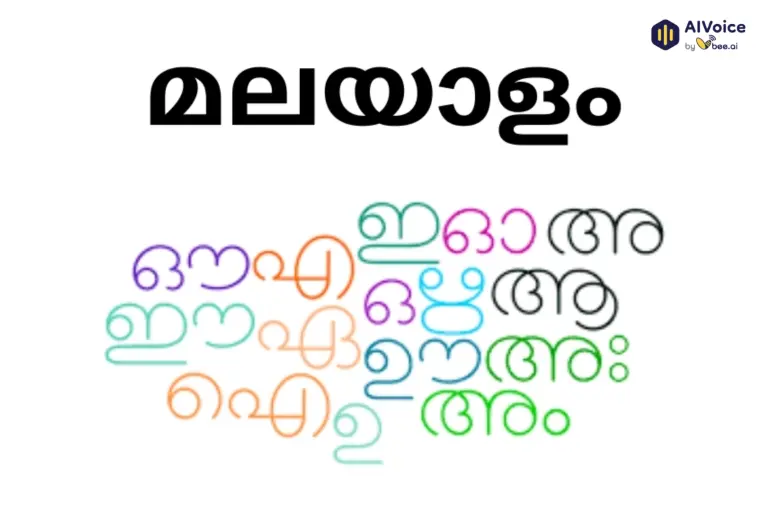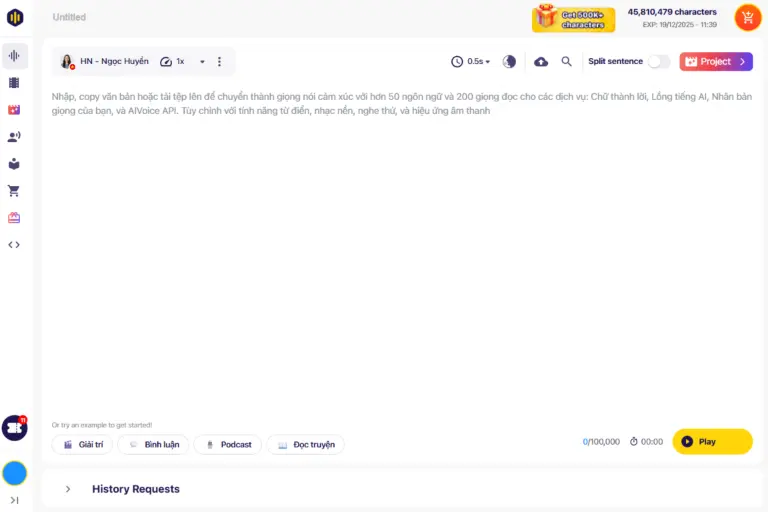Spoken by over 35 million people, Malayalam is the vibrant language of Kerala, carrying centuries of culture, literature, and tradition. Yet in today’s digital-first world, many regional languages struggle to find their place online. Malayalam Text to Speech (TTS) bridges this gap by transforming written words into natural voices, ensuring Kerala’s language not only survives but thrives in the age of AI.
1. Malayalam: A Language of Rich Heritage
Malayalam stands as one of India’s most sophisticated classical languages, with a literary tradition spanning over a millennium. Spoken by approximately 38 million people worldwide, it serves as the primary language of Kerala and the union territory of Lakshadweep, while thriving in diaspora communities across the Gulf, North America, and Europe.
What makes Malayalam unique is its intricate script system, derived from the ancient Brahmi script, featuring 53 letters including vowels, consonants, and a complex array of conjunct consonants. This orthographic richness, while culturally significant, presents formidable challenges in the digital age. Unlike English or Spanish, Malayalam lacks extensive digital resources – from spell checkers to comprehensive speech databases.
The language faces a digital divide that threatens its relevance among younger generations who increasingly consume content in English or Hindi. Standardization remains complex, with regional variations in pronunciation and writing systems creating additional hurdles for technology developers. These challenges have historically limited Malayalam’s presence in the global digital ecosystem, but Text-to-Speech technology offers a transformative solution.
2. Enter Malayalam Text to Speech
Imagine reading a beautiful Malayalam poem by Kumaran Asan on your screen – the words are there, the meaning clear, but something essential is missing. Now imagine hearing those same verses flow from your device in authentic Malayalam pronunciation, with proper intonation capturing the rhythm and emotion of the original verse. This transformation from silent text to living voice represents the revolutionary power of Malayalam Text-to-Speech technology.
TTS serves as a crucial bridge between the written word and auditory experience, breathing life into digital Malayalam content. When you hear Malayalam TTS, you’re not just processing information – you’re experiencing the language’s natural cadence, its unique retroflex sounds, and the subtle tonal variations that make Malayalam distinctly beautiful.
What sets Malayalam TTS apart from other language systems? The complexity is extraordinary. Malayalam features phonemes that don’t exist in most world languages, including specific retroflex consonants, aspirated sounds, and vowel combinations that require precise algorithmic understanding. The language’s agglutinative nature, where words can be formed by adding multiple suffixes, creates pronunciation challenges that AI systems must navigate with remarkable sophistication.
Moreover, Malayalam’s regional variations – from the crisp Kottayam dialect to the unique Malabar inflections – demand TTS systems that can adapt to diverse phonetic patterns while maintaining authenticity and naturalness.

3. Tools & Innovations
The Malayalam TTS landscape represents a fascinating convergence of global tech giants and innovative local solutions, each contributing unique strengths to this technological revolution.
3.1 Global Platforms Meet Local Needs
Tech giants like Google Cloud Speech, Microsoft Azure, and Amazon Polly have laid crucial groundwork by incorporating Malayalam into their multilingual TTS offerings. These platforms provide the robust infrastructure and scalable architecture necessary for widespread adoption. Google’s WaveNet technology, in particular, has made significant strides in capturing Malayalam’s tonal subtleties, while Microsoft’s neural voice synthesis brings emotional expression to Malayalam speech.
However, the real innovation occurs where global technology meets local expertise. Indian startups and research institutions are pioneering approaches that understand Malayalam’s cultural context. Companies like Sarvam AI are developing region-specific models that capture not just pronunciation but the cultural nuances embedded in Malayalam speech patterns.
3.2 The Asian Innovation Wave
Particularly noteworthy is Vbee’s emergence as a significant player in the Asian TTS market. Their multilingual approach recognizes that Malayalam speakers often code-switch between languages, and their systems handle these linguistic transitions with remarkable fluency. This understanding of Asian linguistic diversity positions them uniquely to serve the large Malayalam-speaking populations across the Gulf countries and Southeast Asia.
Creating content for the Indian market? Explore our diverse range of offerings, including Hindi text-to-speech, Indian-accented English text-to-speech voices, Gujarati speech generators, Tamil text to speech online voices, Kannada text to voice generators, Punjabi text to speech voice makers, and Telugu text readers.

Vbee provides 2 Malayalam text to speech male and female voices. Listen to the audio audition below:
| Kăi Zé | |
| Xĩ Wén |
Vbee Text to Speech simplifies the process of producing videos and audio files with realistic sound using text. Begin your journey with our free Malayalam text-to-speech service. Choose from one of our male or female Malayalam voices below, and input your text to generate the audio effortlessly.
Apart from these voices, you can choose other Indian voice. Vbee offers a vast selection of 400 Text to Speech Voices spanning 50 languages.
- Hindi Text to Speech
- Punjabi Text to Speech
- Tamil Text to Speech
- Telugu Text to Speech
- Gujarati Text to Speech
- Kannada Text to Speech
- Bengali Text to Speech
For additional features such as uploading Word documents, controlling voice speed and volume, explore our tools section for more options.
Read more: हिंदी स्पीच सिंथेसिस
4. Beyond Technology: Why It Matters
Malayalam Text-to-Speech transcends mere technological convenience; it represents cultural preservation and linguistic empowerment in the digital age. When we give Malayalam a digital voice, we’re ensuring that this ancient language doesn’t just survive the AI revolution – it actively participates in shaping it.
4.1 Language Preservation Through Innovation
Every time a Malayalam TTS system accurately pronounces a classical poem or correctly intones a traditional song, it preserves phonetic knowledge that might otherwise be lost. For diaspora communities, TTS technology becomes a bridge connecting children to their ancestral language, allowing them to hear proper Malayalam pronunciation even when surrounded by other languages.
4.2 Digital Presence and Global Reach
Malayalam TTS enables the language to claim its space in emerging digital frontiers. Imagine Malayalam-speaking AI assistants helping with daily tasks, voice-guided navigation systems using Malayalam directions in Kerala, or interactive educational content that makes learning Malayalam engaging for global audiences. This technology positions Malayalam to participate meaningfully in the metaverse, where voice interaction will be fundamental.

4.3 Creative Renaissance
Perhaps most excitingly, Malayalam TTS is catalyzing a creative renaissance. Podcasters can now create content without expensive studio setups, educators can develop interactive learning materials, and storytellers can bring Malayalam literature to life through audio experiences. Independent creators are using TTS to produce Malayalam audiobooks, making classical literature accessible to visually impaired audiences and busy commuters alike.
The technology also democratizes content creation for smaller regional languages. A Malayalam content creator in a remote village can now produce professional-quality audio content that competes globally, breaking down traditional barriers to media production.
5. Malayalam text to speech frequently asked questions
Certainly! Feel free to ask any specific questions you have about Malayalam online text-to-speech voices, and I’ll do my best to provide answers and information.
5.1 Is there a text to speech website for Malayalam?
Yes, there is a text-to-speech website for Malayalam called Vbee. You can use Vbee to effortlessly generate Malayalam MP3 and WAV files from text, Word files. Additionally, it allows you to convert PowerPoint presentations into Malayalam language videos. Simply input your text into the script field, choose one of the Malayalam AI voices, and click “Create Audio” to generate the desired audio output.
5.2 Is Malayalam TTS available for free?
Yes, many platforms offer free trials or limited use of Malayalam voices. However, premium plans provide higher-quality audio, more voice options, and commercial rights.
5.3 Can Malayalam TTS be used for YouTube videos or podcasts?
Absolutely. Content creators often use Malayalam TTS to generate voice-overs for videos, audiobooks, and podcasts without the need for recording equipment.
5.4 Does Malayalam TTS support different accents or styles?
Some advanced platforms provide multiple voices and speaking styles (male, female, formal, casual), though the variety is still growing compared to global languages like English.
5.5 How accurate is the pronunciation in Malayalam TTS?
Modern AI-driven TTS solutions are highly accurate, but pronunciation may vary slightly depending on the complexity of Malayalam words and the platform used.
Malayalam Text-to-Speech represents far more than a technological tool – it’s the digital incarnation of a living language, a bridge between Kerala’s rich past and its technological future. By transforming written Malayalam into authentic spoken word, TTS technology ensures that this beautiful language doesn’t just survive in the digital age but flourishes within it.
Contact Info:
VBEE TEXT TO SPEECH
- Phone: (+84) 249 999 3399 – (+84) 901 533 799
- Website: vbee.vn
- Email: contact@vbee.ai
- Address: Floor 15, Ngoc Khanh Plaza, No. 1 Pham Huy Thong, Ba Dinh District, Hanoi, Vietnam.

